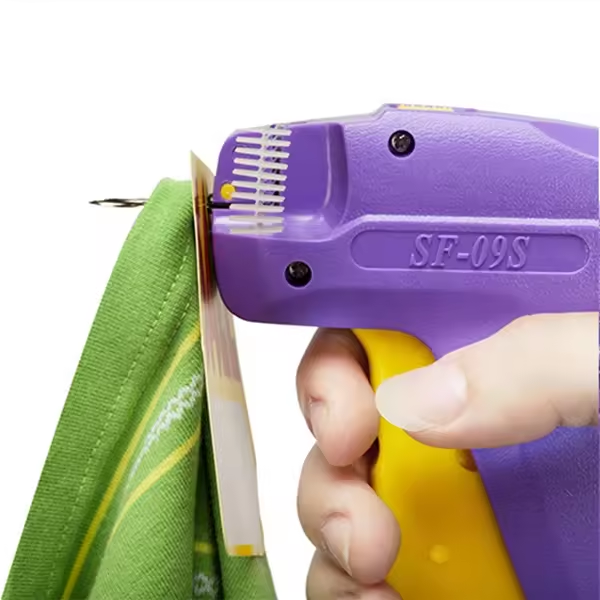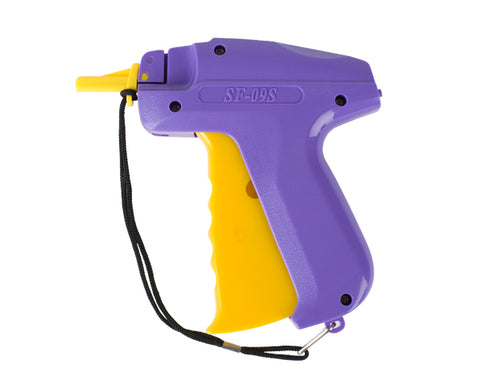Maximizing Efficiency in Retail: The Rise of Clothing Plastic Tag Guns

What Are Clothing Plastic Tag Guns and How Do They Work?
Understanding the Basics of Tag Guns
clothing plastic tag guns are tools used in retail to attach price tags to items. They have a pointed needle and use plastic fasteners. Tag guns are easy to hold and operate. Retail workers just squeeze the trigger to insert a tag. This tool is quick and does not harm the fabric. It makes attaching tags simple. Retail staff can learn to use it in no time. This tool is key for a fast, clean tagging job.
The Mechanism Behind Plastic Fasteners in Tagging Guns
Plastic fasteners in tagging guns are simple yet clever. At the press of a trigger, the gun shoots a thin plastic T-bar fastener through the label and item. This T-bar is part of a continuous 'clip' of fasteners loaded in the gun. Each press aligns a new fastener into place. This makes tagging quick and easy. The fasteners come in different lengths to suit various types of clothes and items.
Benefits of Using Clothing Plastic Tag Guns in Retail
Speeding Up the Tagging Process
A clothing plastic tag gun can quicken the tagging task. With it, attaching price tags and info labels is fast. Workers spend less time on each piece of clothing. This tool allows for more items to be tagged per day. That means clothing stores can get products on shelves quicker. This speed boost is vital during busy times like sales or new arrivals. In short, tag guns help shops work faster, aiding in higher productivity.
Ensuring Consistency and Professionalism
Using a clothing plastic tag gun offers more than speed; it ensures each tag is placed consistently. This leads to a uniform look across all products, giving your store a professional appearance. Customers trust neat, well-organized retail spaces. With each item neatly tagged in the same manner, your shop reflects a high standard of care. This attention to detail can boost consumer confidence and enhance the overall shopping experience.
Reducing Damage to Merchandise
The use of plastic tag guns in retail brings with it a distinct advantage - the reduction of damage to merchandise. Traditional tagging methods, like safety pins or staples, can harm the fabric. Tag guns, however, use a sharp needle and plastic fasteners for a clean insert.
- Minimize tears and holes: The fine needle reduces puncture size, preserving the garment's integrity.
- Avoid snags: Fasteners are smooth, preventing snagging on fabrics like silk or linen.
- No marks: Unlike staples, plastic tags leave no rust or imprint marks that could spoil the item's appearance.
Selecting the Right Clothing Plastic Tag Gun for Your Business
Features to Look for in a Tagging Gun
- Needle Quality: Opt for a tag gun with a high-quality needle to ensure smooth operation and minimal fabric damage.
- Ergonomic Design: A comfortable grip reduces hand fatigue during extended use.
- Durability: Look for sturdy construction that can withstand the daily demands of retail.
- Fastener Compatibility: Choose a tagging gun that works with various fastener sizes and types for flexibility.
- Ease of Loading: A tagging gun that allows for quick and simple reloading saves time.
- Safety Features: Consider models with protective needle covers or lock mechanisms to prevent accidents.
- Adjustable Tension: Some tag guns offer adjustable tension for different types of fabric, preventing damage.
Best Practices for Using Tag Guns Effectively
When selecting a clothing plastic tag gun, it's not just about picking the right tool; it's also about how you use it. Here are some best practices for using tag guns effectively:
- Always ensure the tagging gun is loaded correctly with the right size of plastic fasteners for your tags.
- Practice proper technique by placing the gun's needle exactly where you want the tag to be attached.
- Apply gentle pressure, to avoid damaging the merchandise when attaching the tag.
- Test on a piece of scrap material first if you are new to using tagging guns.
- Keep the gun's needle clean and clear of any obstructions for a smooth operation.
- Train all employees on the correct usage to maintain tagging consistency.
- Always replace the needle as soon as it becomes dull or bent to ensure a clean insertion every time.
Following these steps can help maximize the lifespan of your tagging gun and maintain the quality of your tagged merchandise.
Maintenance Tips for Long-Lasting Use
- Regularly inspect the tagging gun for any signs of wear or damage.
- Clean the needle and inside the gun frequently to remove any built-up residue.
- Store the tagging gun properly when not in use, away from dirt and moisture.
- Follow the manufacturer's instructions for any specific maintenance requirements.
- Replace the needle promptly if it becomes blunt or bent to ensure efficient operation.
- Use only compatible plastic fasteners to prevent jamming and wear on the gun.
- Train staff on proper handling and storage of the tag gun to prevent accidental breakage.
Related articles:
What Is The Difference Between A Standard And Fine Tagging Gun?
Choosing the Right Tag Pin and Tag Gun
How to Load a Tagging Gun?
What Are Tag Guns?



